

|
Home Updates Hydros Cars Engines Contacts Links ←PIt Box 24 Pit Box Index |
|
Pitbox 25 |
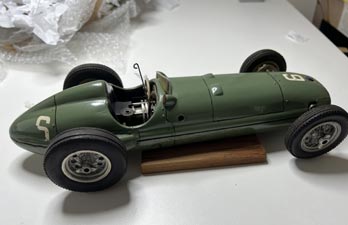 |
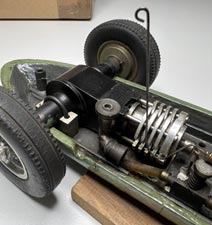 |
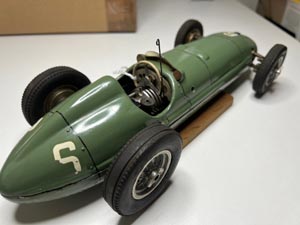 |
| BRM with a hidden surprise When this BRM appeared for sale it was hoped that it was yet another Henri Baigent model as someone had taken a lot of trouble enhancing the model with various details. No, it was a very well made home build, but with a surprise lurking under the body. Instead of the expected ERE there was a very early Oliver twinshaft. Difficult to pin down exactly what version it is but most likely a Nine Port. A very neat conversion has been made to the sideport venturi to keep it within the body, rather than sticking out as is more normal. Amazingly, the car and tyres are in excellent condition despite having been around for seventy five years. Thanks to the owner for this item and photos Dec 2025 |
||
|
Two vintage diesel
cars
from Jan Erik Falk, |
|
|
|
|
|
|
|
Jan Erik Falk's long and distinguished tethered car racing career began in the very early 1950s with his first European Championship meeting in 1956. He won his maiden championship in 1961 and has continued to add World and European Championships regularly from then on to the present day, his most recent being this season. Two early cars here, a typical Swedish twinshaft with a home built engine and an extremely close fitting and streamlined body. The bevel drive car is another gem with a streamlined, hand beaten body, the likes of which we just don't see from the same period in the UK. Thanks to Oliver Monk for the photos Nov 2025 |
||
 |
 |
| Dooling Arrow Nothing unusual about this car, apart from its 'back story'. It was bought and run in the USA by the late Tony Higgins when he worked there. On his return to the UK he brought this, along with other cars and engines, back with him where it stayed until he sold most of them on many years later. The car is seen in an illustration from an ME article in 1978, still with its original Bruce Underwood Yellow Jacket YJ61C. Having passed through the hands of a notorious dealer it was sold on to a British tethered car enthusiast, but magically, the Underwood YJ had morphed in to a very ordinary and not particularly good standard Dooling 61. The other side of the body carries decals attesting to its origins and the YJ motor and we have a pretty good idea of where the engine might have gone, but now the car is no longer original as it was in 1978. |
|
 |
 |
| Carter Dooling 61 At least, that is how it was advertised and what the box had printed on it. It has elements of Fred Carter about it but again there is a trail back to 1978 where it was captioned as 'a Dooling special' with a claim of having achieved 186mph in a plane? No mention of Carter at that time and a somewhat dubious speed quoted. Whether the odd lug shape was down to damage or deliberate is not known, but in another quirk of fate, it transpired that Tony had loaned the engine to Dave Smith a renowned British speed flyer and very knowledgeable with regards to Carter engines. Dave stripped it down and noted that the piston and liner were standard Dooling, and in addition has retained the photos he had taken. So when did it become a 'Carter Dooling' as opposed to a 'Dooling Special'? The late owner of this engine also bought a plane with a 'very special Carter Dooling 29' in it that turned out to be a bog standard product from the Dooling factory, at which point the value plummeted to about 20% of what it had been. The moral of both these tales is that if buying from a dealer or third party make sure what you are getting is what it should be and what you are paying for. |
|
 |
 |
 |
| Arne Zetterstrom 5cc
We first became aware of this car back in
2016 when it was part of the sale of the late Arne Zetterstrom's
huge collection of cars, engines, projects and spares. Arne was
both a prolific builder and successful competitor in Sweden and
at International events, winning the first of his eight European
Championships in 1955, adding a World Championship in 1958. His
engineering was exquisite, with very little in any of his cars
being left standard. This Dooling powered 'super Slabang' from
1958 is no
different, with many modifications to the motor. It remained
unsold until Arne's son Per turned up at Orebro earlier this
year with a selection of cars for sale. It was brought back to
the UK, taken to Buckminster where it ran happily for the first
time for decades without anything being touched. It is now a
regular visitor to the track joining the other vintage 5cc cars. |
||
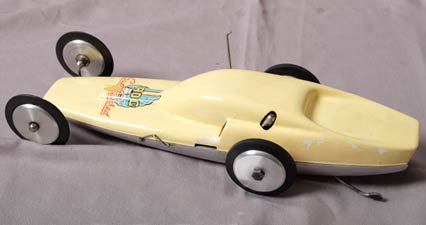 |
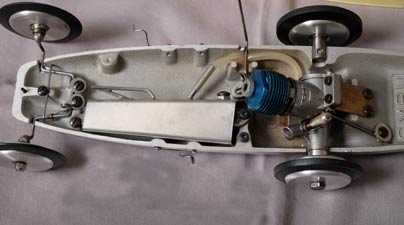 |
| SMRU
Almost from the beginning of the modern
tethered car era, there has a desire for a category that is
cheaper and easier to run for beginners or new entrants to the
sport. We covered the history and 'hijacking' of the European
attempt, but over in Scandinavia there was a different approach
that resulted in the car seen here, common in Sweden, but
virtually unknown elsewhere. Its origins began with Lars Olaf
Johanessen back in 1970 when the design for the SMRU was
published. The name is derived from the Svenske Modell
Racer Unionen, the Swedish federation. The
instruction begin with 'you don't need power tools of any kind,
but a few hand tools are needed'. Power is from a 1.5cc aero
engine with a single wheel drive and one slave wheel, wire
front suspension, wire knock off and a tank soldered up from
brass or tin sheet. The instructions include a development of
the tank and full building instructions (also available in English). Whilst successful in Sweden, the only ones that have
migrated to the UK have proved impossible to start on the track,
possibly due to the choice of engines fitted? |
|
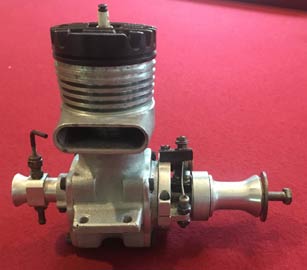 |
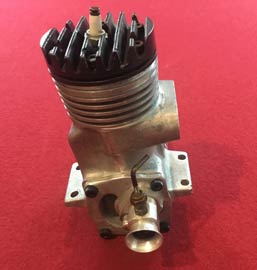 |
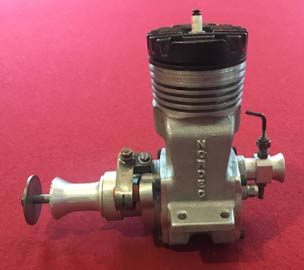 |
| Nordec Special Series II
We have previously shown
two examples of this motor that was to be the next version of
the Nordec produced by the North
Downs Engineering Company. Unfortunately, due to changes in
personnel, the purchase tax case and a factory relocation, the
Special Series II never got beyond the prototype stage before
the company ceased to manufacture model engines. The Series II
is easily identifiable through the much wider transfer bulge,
the deeper exhaust stack and
most importantly, the monobloc crankcase casting, although this
was due to be changed to the standard, removable fins on the
production version. Neither were the pre-production prototypes
ever blacked as the earlier versions were. What makes this motor unique (so far) is
that it is the only one that has not seen duty in a speed plane
so still has its full exhaust stack and the NORDEC letters on
the transfer. What none of them have is the downdraft venturi backplate that John Wood appeared to be working on when the
manufacture of engines ended in 1950. The venturi on this
engines appears to be a non Nordec replacement and why the
standard R10 front housing? We can however
finally confirm that the motor previously claimed to be a Series
II is actually a standard R10 and that the backplate with the
down draft venturi is from a completely different motor and that
the second downdraft backplate photographed is a standard Series
I with a neat elbow on the bottom of the venturi. |
||
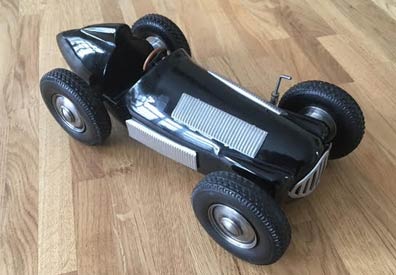 |
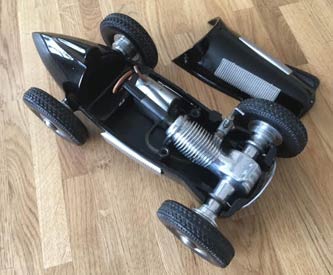 |
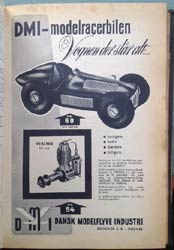 |
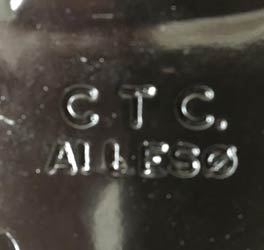 |
|
Viking tethered car
From Denmark
comes this tethered car
produced in 1948-1950, by the company CTC 'Claus Thorlund
Clausen' Alles°, who also produced the Danish Viking Engines,
and was distributed through DMI ľ 'Dansk Modelflyve Industri'
Notice that the compression is set by the steering wheel! The
engine shown on the advertisement is a VIKING 2,5 which was done
also in 3,2 ccm and also in a double shaft version. The engine(s)
were done in more than 21.000 pcs |
|
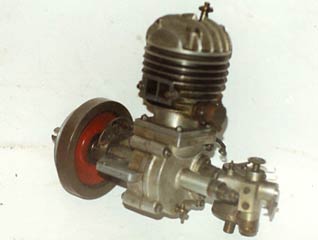 |
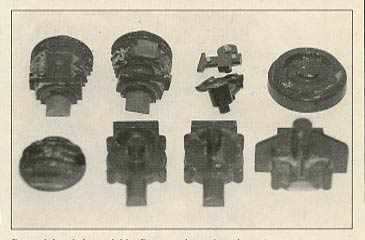 |
| Brown Hydro motor
Prior to WW2 the 30cc hydro A class was
dominated by single cylinder four stroke motors with those using two
strokes, very much in the minority. This was mainly as development lagged behind with
the main source of designs and information being Edgar Westbury
through the pages of Model Engineer. Some did persist with two
strokes as there were inherent advantages with the much lighter
weight and mechanical simplicity. Options were limited so many
resorted to building their own motors from scratch, including Bob
Brown of Brighton who made the patterns and built this 30cc motor in
the late 1930s. A very compact back end with a rotary valve and
engine mounts on the front half of the casting only, simplified
construction somewhat. In a large scow type hull the engine was good
for 40+mph, which matched many of the run of the mill four strokes.
In the 1990s, the engine, drawing and patterns were passed to Peter
Hill, current whereabouts unknown. |
|
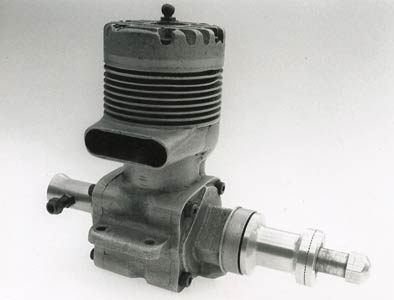 |
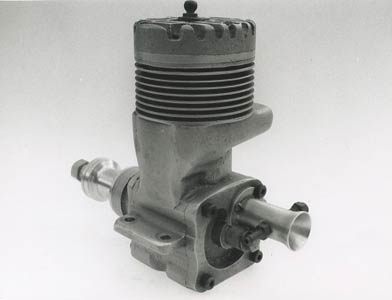 |
| IR 10
The late Ian Russell was well known for his
model flying activities and later his commercial engine
building. However this motor is an example of an earlier attempt
by Ian to build a British motor to compete with the McCoy 60. It
shows elements of both the McCoy and the Nordec, but apart from
that nothing more is known and just these two photos that turned
up after Ian's death are
evidence that it ever existed. It is possibly out there
somewhere if anyone recognises it? |
|
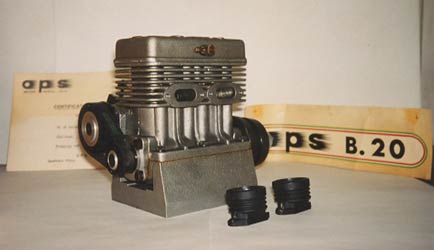 |
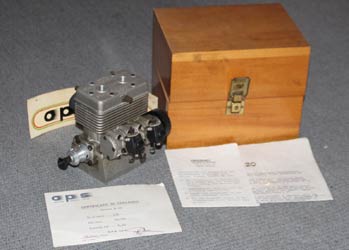 |
| OPS B20 Two more examples of the relatively rare but very very expensive OPS twin, built in limited numbers in the 1970s. The motor on the right is exactly as it was when Gualtiero Picco passed it to a fellow tethered car racer. It still has the original prop driver from its test run where the certificate states that it produced 4.1bhp at 20,500rpm, signed by both Picco and Piero Muzio. Both engines are from the very first production run, number 5 on the left and 18 on the right. Oddly, the documentation is for a later engine though, so someone out there probably has the certificate for #18. See this month's Pylon for the history of the B20. |
|
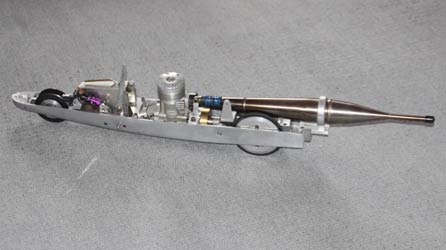 |
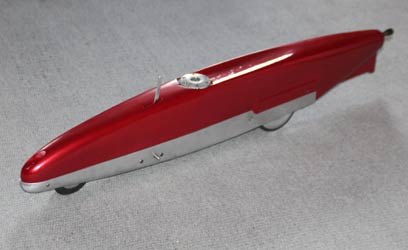 |
|
|
|
| The 'portly' Picco On the face of it this looked like a 'put everything together' project, but that could not have been further from the truth. All the parts in the finished car were there, but nothing fitted. See this month's Pylon for the full, sorry saga. As the top photos show, perseverance and ingenuity had a complete, but effectively useless car. |
|
ęcopyrightOTW2025